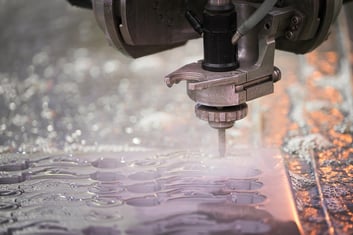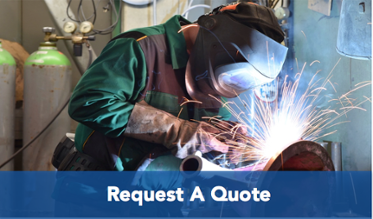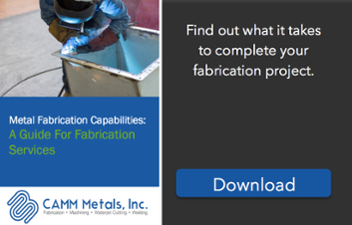 Over the years, water jet cutting has become an increasingly popular cutting method used for a wide variety of projects. Compared with other cutting methods, waterjet cutting yields cleaner results, more precision and reduced costs without some of the drawbacks associated with other methods, like thermal distortion or rough finished edges.
Over the years, water jet cutting has become an increasingly popular cutting method used for a wide variety of projects. Compared with other cutting methods, waterjet cutting yields cleaner results, more precision and reduced costs without some of the drawbacks associated with other methods, like thermal distortion or rough finished edges.
This blog post will help you to determine if waterjet cutting is the proper choice for your next project. We’ll cover how waterjet cutting works, its best uses, and the primary benefits.
How Does Waterjet Cutting Work?
Waterjet cutting machines use a high pressure stream of water, which is then converted to velocity via a jewel orifice, which then creates a stream as fine as human hair.
The high velocity process can cut through almost any material; pure wateriest are used for cutting softer materials, and abrasive wateriest are best suited for cutting harder materials. When using abrasive cutting techniques, garnet, the abrasive material is introduced into the stream to increase pressure, resulting in a cutting velocity which is much faster. The force of the water and abrasive creates something akin to a liquid sandpaper mixture that erodes the material at a rapid pace.
From there, the abrasive jet stream is moved across the material, adhering to the measurements input into the control system. The ideal movement speed depends on several factors, including the material, the shape of the part, the water pressure, and the type of abrasive.
What are the Primary Benefits of Waterjet Cutting?
Can Cut Almost Any Material
The most popular materials cut by a waterjet are metals (especially aluminum, considering its relatively soft and cuts quickly). There aren’t many materials that waterjets cannot cut. Diamonds and tempered glass are the two main materials that waterjets cannot cut. Diamonds are too hard to cut, and tempered glass shatters when it is cut with a water jet; however, it’s important to note that tempered glass is designed to shattered when its disturbed (this is why it’s frequently used in windshields).
There are a few advanced ceramics that are so hard that it’s not economically feasible to cut them and some composite materials (layers of different materials sandwiched together) that can’t be cut because the water can pressurize the in-between layers and “delaminate” the materials. That being said, there are some composite materials that can be cut just fine, and there are techniques to cut laminated materials quite effectively.
No Secondary Finishing Required
Typically, it takes one session with the water jet to produce the exact cut you were looking for. Unlike many other cutting techniques, there is usually no secondary finishing required. Once it’s done cutting, it’s ready for you to take with you. The delicacy and exactitude of the waterjet creates a satin smooth edge with minimal kerf. Often, wateriest have a stream about 0.02” wide, resulting in a narrow kerf that removes a very small amount of material. This can be very beneficial if the operator is working with expensive or hazardous material. In the end, you can save quite a bit of money or have more material to work with, when the kerf width is minimal.
Cold Cutting Process
Waterjet cutting is a cold cutting process, unlike most other cutting techniques. Cold cutting means that there is almost no heat generated on the part being cut. The little heat that is generated is absorbed by the water. This benefit is immensely valuable when you are trying to produce an end product that can’t have distortion from a heat-affected zone (HAZ, for short).
HAZ is the area where high temperatures have caused distortion to the base material, meaning the heat has caused chemical and structural changes that can often result in brightly colored bands around this zone. HAZ can damage and distort parts, causing a flawed cut that requires secondary work to be fixed.
Since water jet cutting is a cold cutting process, it does not heat the material, resulting in no heat-affected zones or thermal distortion on the material.
Useful to a Variety of Industries
The diversity of a waterjet machine’s cutting ability allows the machine to be incredibly useful and valuable for a wide variety of industries. Here are a few industries that benefit from waterjet cutting:
- Aerospace: We’ve create parts for the aerospace industry and have machined lots of aluminum, which is easily machined on a water jet. Wateriest can also be used to machine exotic metals like Inconel®, titanium and Haastelloy, which are all important for the aerospace industry.
- Manufacturing: Waterjets are frequently used for creating parts of products that are sold, as well as many of the parts used to make the machines on assembly lines.
- Automotive: Wateriest can help with prototyping and production parts for automobiles, and the tooling for making automobiles.
- Model Shops/ Rapid Prototyping: Fast turn-around of single piece production in nearly any material helps to make waterjets great for these kinds of applications.
CAMM Metals | Waterjet Cutting Services
At CAMM Metals, we use waterjets in several different ways. First, we use them to cut all of our flat sheet metal and plate to feed the fabrication work we do. The precision from the waterjet is just as good as laser cutting and better than plasma cutting. Second, we use these machines to process thick plates and pre-cut shapes and blanks for our CNC Machining centers. Third, we offer water jet cutting as a service to customers who do not have this capability. We can use our material or you can drop ship us your material and generally within 3 days your parts will be cut and ready to go. Lastly, we can cut round and rectangular tubes and pipes.




